
- •Preface
- •Content
- •Tissues
- •Nerve Tissue
- •Skin - Epidermis
- •Skin - Dermis
- •Skin - Glands
- •Subcutaneous Layer
- •Skeleton
- •Axial Skeleton
- •Cranium
- •Cranial Bones – Inferior Nasal Concha
- •Vertebral Column
- •Sacrum and Coccyx
- •Ribs
- •Sternum
- •Clavicle
- •Scapula
- •Humerus
- •Ulna
- •Radius
- •Metacarpals and Phalanges
- •Pelvis - Male
- •Femur
- •Tibia
- •Fibula
- •Tarsal Bones - Cuboid and Navicular
- •Phalanges
- •Patella
- •Skeletal Muscles
- •Transversospinales Muscles
- •Cervical Hypaxial Muscles
- •Thoracic and Abdominal Hypaxial Muscles
- •Shoulder Muscles - Rotator Cuff
- •Shoulder Muscles - Prime Movers
- •Anterior Brachial Muscles
- •Posterior Brachial Muscles
- •Posterior Thigh Muscles
- •Thigh Muscles
- •Lateral Leg Muscles
- •Posterior Leg Muscles
- •Spinal Nerves
- •Dorsal Rami
- •Intercostal Nerves
- •Cutaneous Nerves
- •Autonomic Nerves
- •Spinal Cord
- •Brain
- •Cerebrum
- •Cerebellum
- •Meninges
- •Hypothalamus
- •Pituitary Gland
- •Pineal Gland
- •Thymus
- •Pancreas
- •Ovaries
- •Testes
- •Blood
- •Heart
- •Lymphatics
- •Larynx
- •Lungs
- •Cast of Trachea and Bronchial Tree
- •Esophagus
- •Stomach
- •Pancreas
- •Large Intestine
- •Mesenteries
- •Omenta
- •Female Reproductive Organs
- •Ovary
- •Vagina
- •Ductus Deferens and Spermatic Cord
- •Penis
- •Index
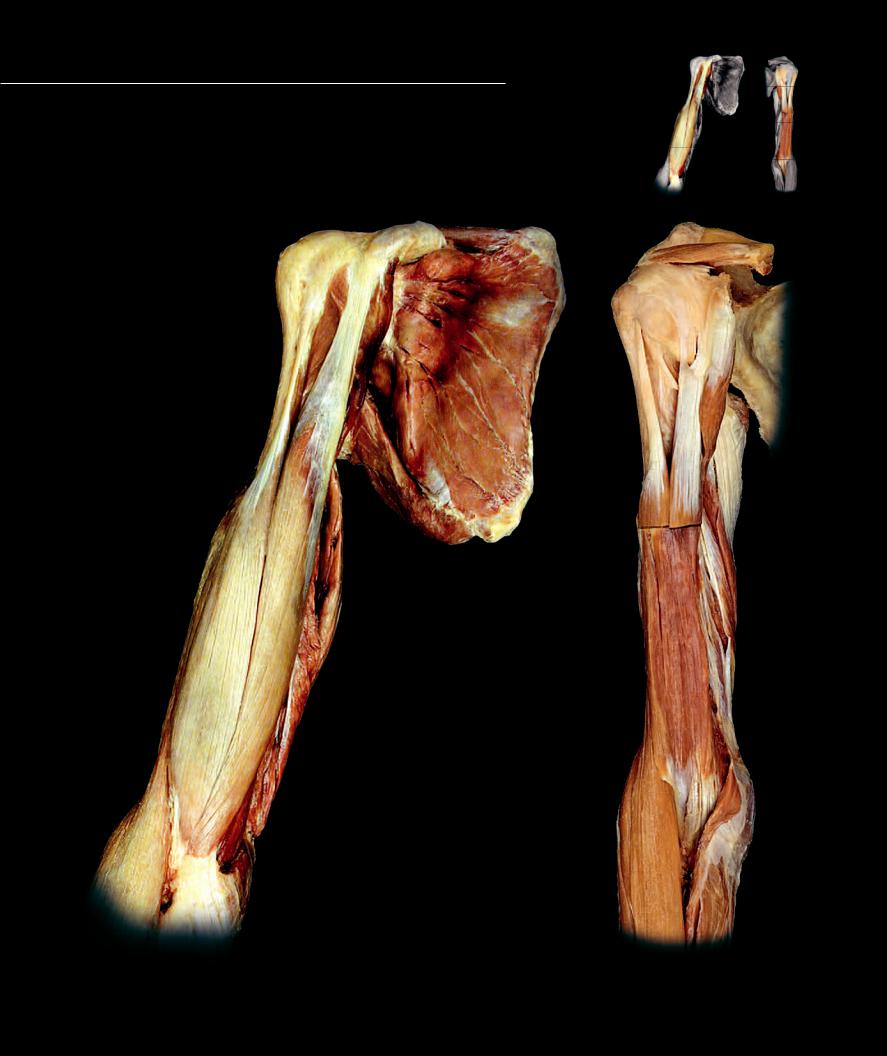
The anterior muscle compartment of the brachium consists of
three muscles — the coracobrachialis, brachialis, and biceps brachii. The coracobrachialis and brachialis each cross a single joint, the shoulder joint and elbow joint respectively. The biceps brachii crosses three joints, the shoulder, and the humero-ulnar and radio-ulnar joints of the elbow. The muscles share in common the actions of fl exion of the shoulder and elbow. All three muscles are innervated by the musculocutaneous nerve.
Anterior Brachial Muscles |
|
|
|
|
1 |
Coracobrachialis |
11 |
6 |
12 |
2 |
Brachialis |
|
|
|
|
|
|
||
3 |
Biceps brachii - long head |
14 |
|
|
4 |
Biceps brachii - short head |
|
|
|
|
|
|
||
5 |
Triceps brachii |
|
|
|
Other Muscles and Structures |
|
|
14 |
|
|
|
15 |
||
6 |
Supraspinatus |
|
|
|
7 |
Subscapularis |
1 |
|
|
8 |
Teres major |
|
|
|
|
|
|
||
9 |
Brachioradialis |
|
|
|
10 |
Pronator teres |
|
|
7 |
11 |
Coracoid process |
|
|
|
|
|
|
||
12 |
Superior angle |
|
|
1 |
13Inferior angle
14Greater tubercle
15Lesser tubercle
8
3 4
13
34
2
5
10
9 |
9 |
Muscles of the right brachium and scapula |
Deep muscles of the right brachium |
|
Anterior view |
||
Anterior view |
||
|
186

The three headed triceps brachii muscle is the sole muscle of the posterior
compartment of the brachium. This large muscle extends the shoulder and elbow joints and is innervated by the radial nerve.
Posterior Brachial Muscles |
|
|
|
|
1 |
Triceps brachii - medial head |
7 |
|
|
2 |
Triceps brachii - lateral head |
13 |
8 |
|
3 |
Triceps brachii - long head |
|
|
|
|
|
|
||
4 |
Biceps brachii - long head |
|
|
|
5 |
Beceps brachii - short head |
|
|
12 |
6 |
Brachialis |
|
|
9 |
|
|
|
8 |
|
Other Muscles and Structures |
|
|
||
|
|
|
||
7 |
Supraspinatus |
|
|
|
8 |
Infraspinatus |
|
|
|
9 |
Teres minor |
|
|
|
10 |
Teres major |
|
|
11 |
11 |
Humerus |
|
|
|
12Greater tubercle
13Spine of scapula
14 Brachail artery |
10 |
|
2
3
4
5
6
11
14
1 |
1 |
2
3
Transverse section of right midbrachim |
Muscles of the right brachium and scapula |
Inferior view |
Posterior view |
187
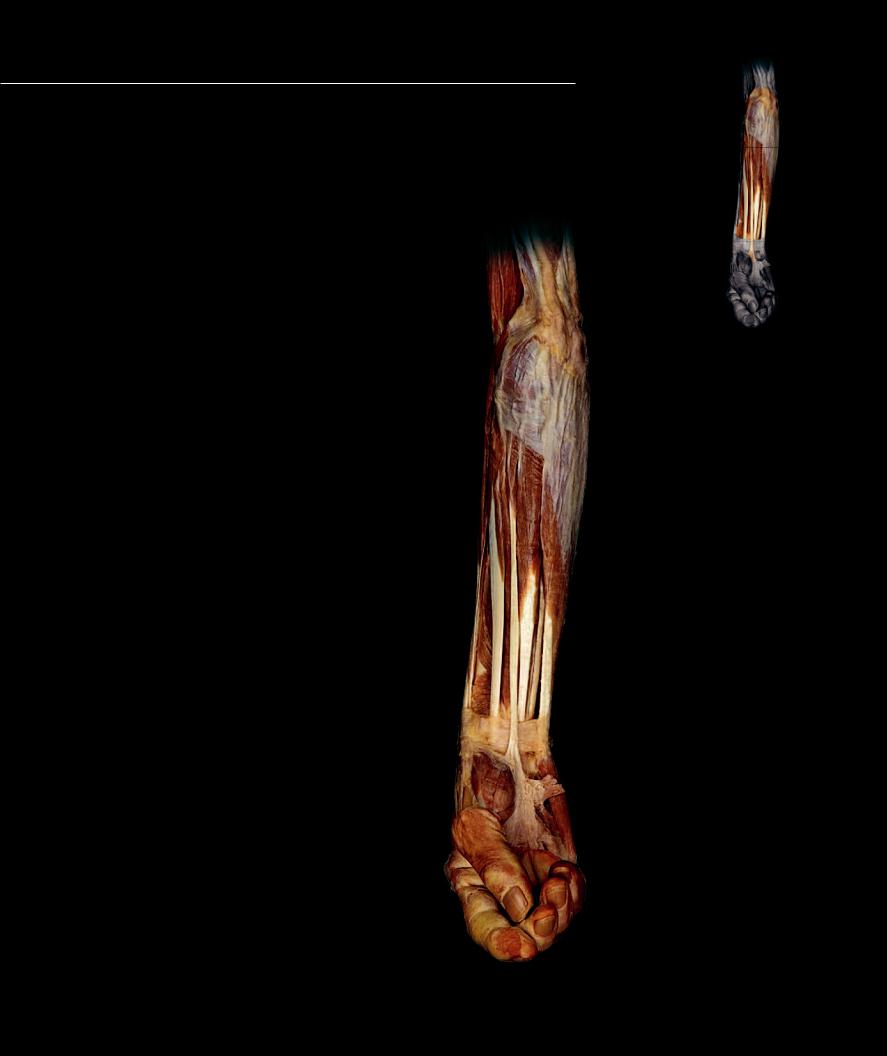
The muscles of the anterior antebrachium form three
distinct muscle layers. The superficial group has four superfi cial muscles (pronator teres, fl exor carpi radialis, palmaris longus, and fl exor carpi ulnaris) covering the intermediate fl exor digitorum superfi cialis. All fi ve of these muscles share a common attachment on the medial epicondyle of the humerus. The three deep muscles (fl exor digitorum profundus, fl exor pollicis longus, and pronator quadratus) do not cross the elbow joint. Other than the two pronators, all the muscles are fl exors of either the wrist or digits. The median nerve innervates all but the fl exor carpi ulnaris and the ulnar half of the fl exor digitorum profundus, both of which are supplied by the ulnar nerve.
Anterior Antebrachial Muscles 1 Pronator teres
2 Flexor carpi radialis
3 Palmaris longus
4 Flexor carpi ulnaris
5 Flexor digitorum superficialis
6 Flexor digitorum profundus
7 Flexor pollicis longus
8 Pronator quadratus
Other Muscles and Structures
9 Brachialis
10Palmar aponeurosis
11Brachial artery
12Radial artery
13Ulnar artery
14Anterior interosseous artery
15Interosseous membrane
16Abductor pollicis brevis
17Flexor pollicis brevis
18Lumbricals
19Adductor pollicis
20Flexor digiti minimi brevis
21Abductor digiti minimi
22Palmaris brevis
23Supinator
24Superficial transverse metacarpal ligament
1
3
25
4
7
8
24
16
22
17 20
10
Superficial muscles of the right antebrachium
Anterior view, hand pronated
188
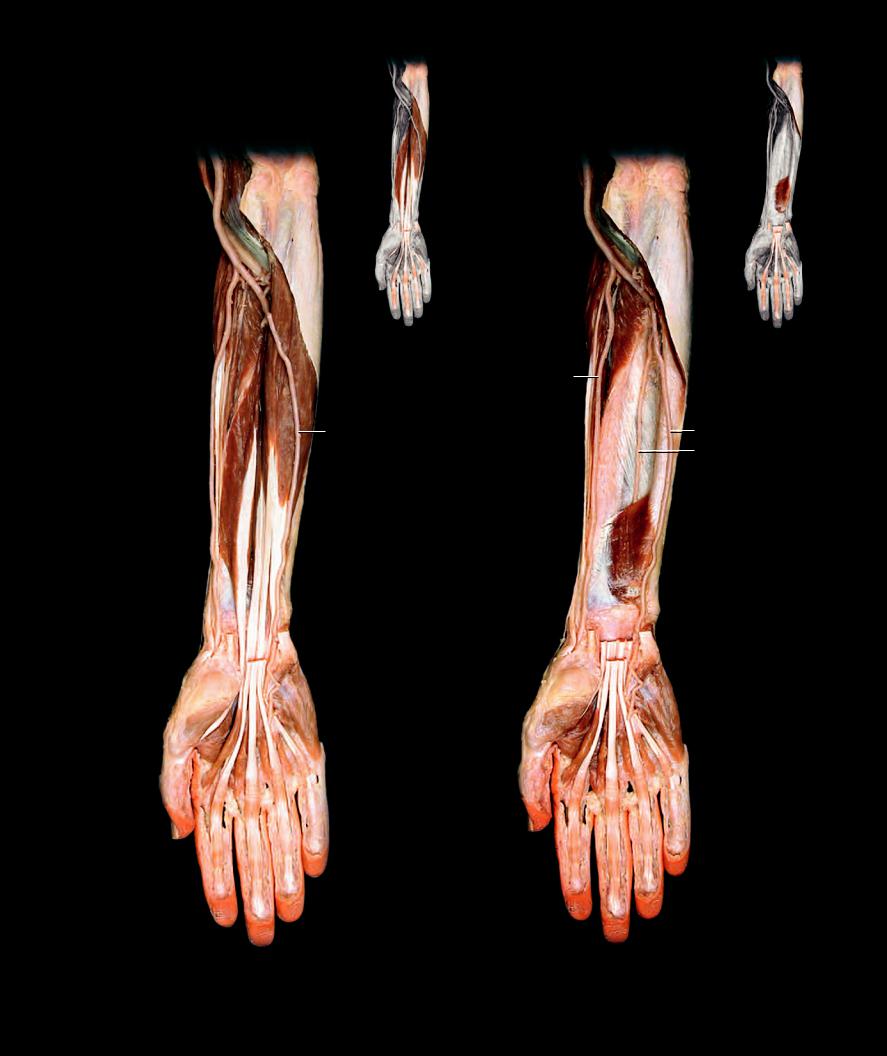
9
11
23
12 
13
6
7
4
2
5
|
|
21 |
|
16 |
|
20 |
|
17 |
|
|
|
1918 |
18 |
18 |
|
18 |
|||
|
|
Deep muscles of the right antebrachium
Anterior view, superficial muscles removed and hand pronated
9
11
23
12
13
14
15
8
2 4
6
5
|
|
|
21 |
16 |
|
|
20 |
17 |
|
|
|
19 |
|
|
|
18 |
18 |
18 |
18 |
|
|
|
Deep muscles of the right antebrachium
Anterior view, muscles removed to expose pronator quadratus
189
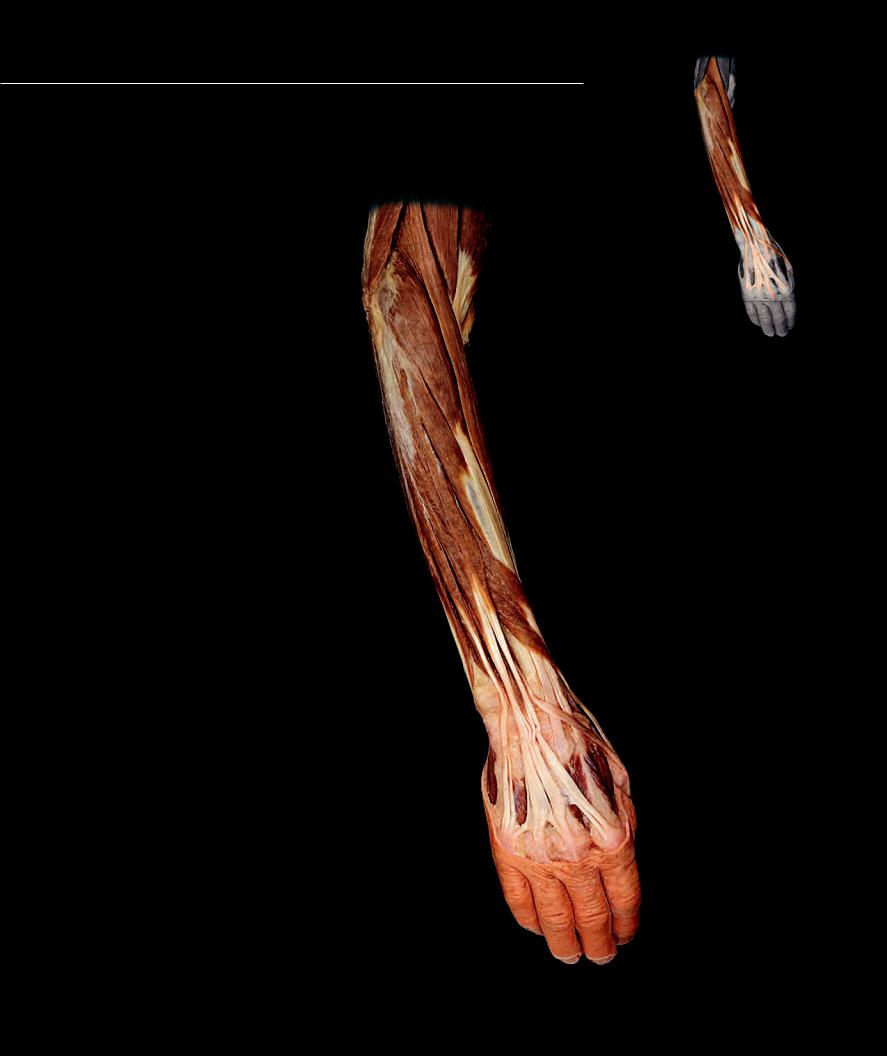
There are two muscle groups in the posterior
antebrachium — the eight muscles of the lateral group that share a common attachment on or near the lateral epicondyle of the humerus and the four muscles of the radial group that course along the distal aspect of the radius to insert on the thumb and fi rst fi nger. Like the triceps of the posterior brachial compartment, all the muscles of the posterior antebrachium receive innervation via the radial nerve. With a few exceptions, the muscles are extensors of either the elbow, wrist, or digits.
Posterior Antebrachial Muscles 1 Brachioradialis
2 Anconeus
3 Supinator
4 Extensor carpi radialis longus
5 Extensor carpi radialis brevis
6 Extensor digitorum
7 Extensor digiti minimi
8 Extensor carpi ulnaris
9 Abductor pollicis longus
10Extensor pollicis longus
11Extensor pollicis brevis
12Extensor indicis
Other Muscles and Structures
13Biceps brachii
14Brachialis
15Triceps brachii
16Flexor carpi radialis
17Pronator teres
18Flexor pollicis longus
19Abductor digiti minimi
20Dorsal interossei
15 14
13
1
2
4
5
6
9
7
11
8
10
20 20
19
20
Superficial muscles of the right antebrachium
Posterior view, hand pronated
190

15
13
14
3
17
9
10 11
12
19
20 20
20 20
13
3
17
16
18
9
11
10
20
Deep muscles of the right antebrachium |
Deep muscles of the right antebrachium |
Posterior view, lateral group muscles removed and hand pronated |
Anterolateral view, lateral group muscles removed and hand pronated |
191
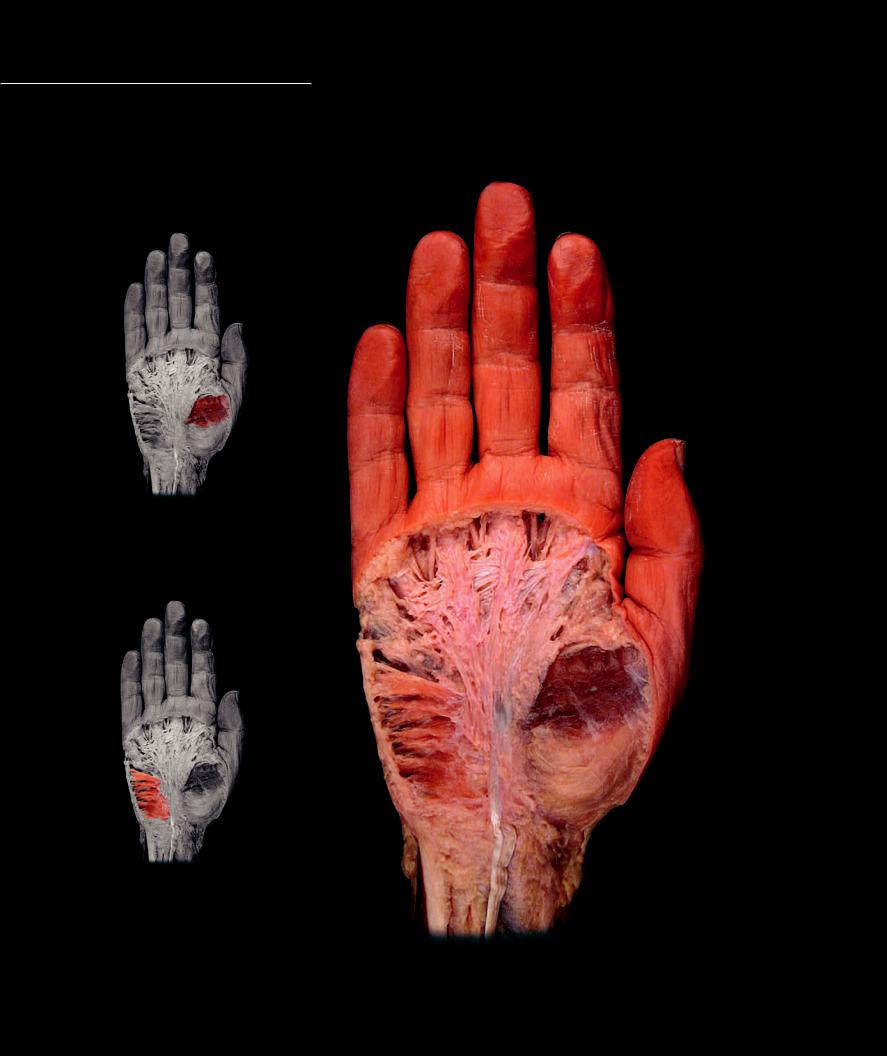
There are three muscle groups in the hand — the muscles of the thenar eminence at the base of the thumb, the muscles of the hypothenar eminence at the base of the little fi nger, and the three layers of intermetacarpal muscles that occupy the
spaces between the metacarpal bones. All of these muscles arise from the anterior muscles of the embryonic limb bud and receive anterior division nerve supply from the median and ulnar nerves as they pass from the anterior antebrachium into the hand. While the median nerve supplies the majority of the muscles of the anterior antebrachium, the ulnar nerve supplies all but three of the muscles in the hand.
Muscles of the thenar eminence
16
2
1
6
Muscles of the |
|
|
hypothenar eminence |
13 |
12 |
Superficial muscles of the right hand
Anterior view
192
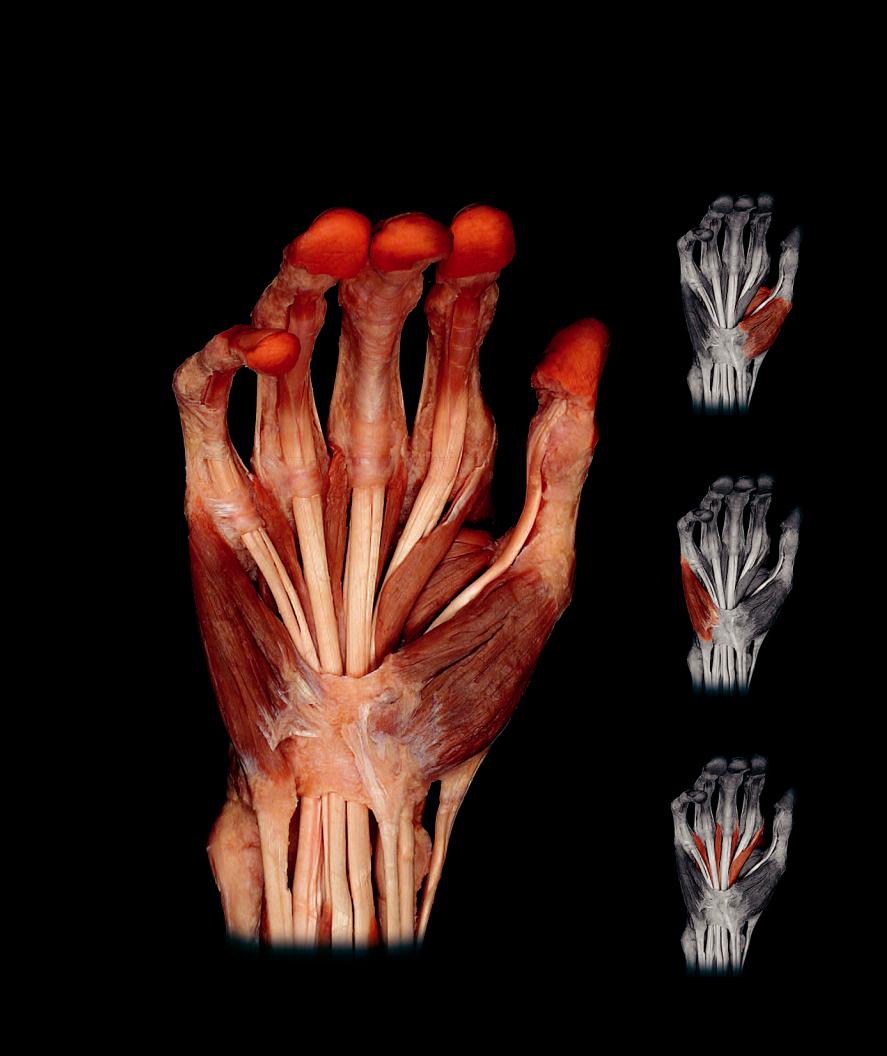
Hand Muscles |
7 |
Lumbricals |
12 |
Palmaris longus |
|
1 |
Abductor pollicis brevis |
8 |
Palmar interossei |
13 |
Flexor carpi ulnaris |
2 |
Flexor pollicis brevis |
9 |
Dorsal interossei |
14 |
Flexor pollucis longus |
3 |
Adductor pollicis |
|
|
15 |
Flexor carpi radialis |
4 |
Abductor digiti minimi |
Other Muscles and Structures |
16 |
Palmar aponeurosis |
|
5 |
Flexor digiti minimi brevis |
10 |
Flexor digitorum superficialis |
17 |
Flexor retinaculum |
6 |
Palmaris brevis |
11 |
Flexor digitorum profundus |
18 |
Ulna |
11
11
Muscles of the thenar eminence
|
7 |
10 |
|
9 |
|
|
|
|
|
|
|
7 |
|
|
|
7 |
10 |
|
|
|
10 |
|
|
|
10 |
7 |
3 |
16 |
|
|
|
|
|
|
8 |
|
|
|
|
5
4 |
2 |
|
|
|
1 |
Muscles of the hypothenar eminence
17
10 10
12
18
13 |
15 |
11
Intermediate muscles of the right hand |
Intermetacarpal muscles |
Anterior view |
193
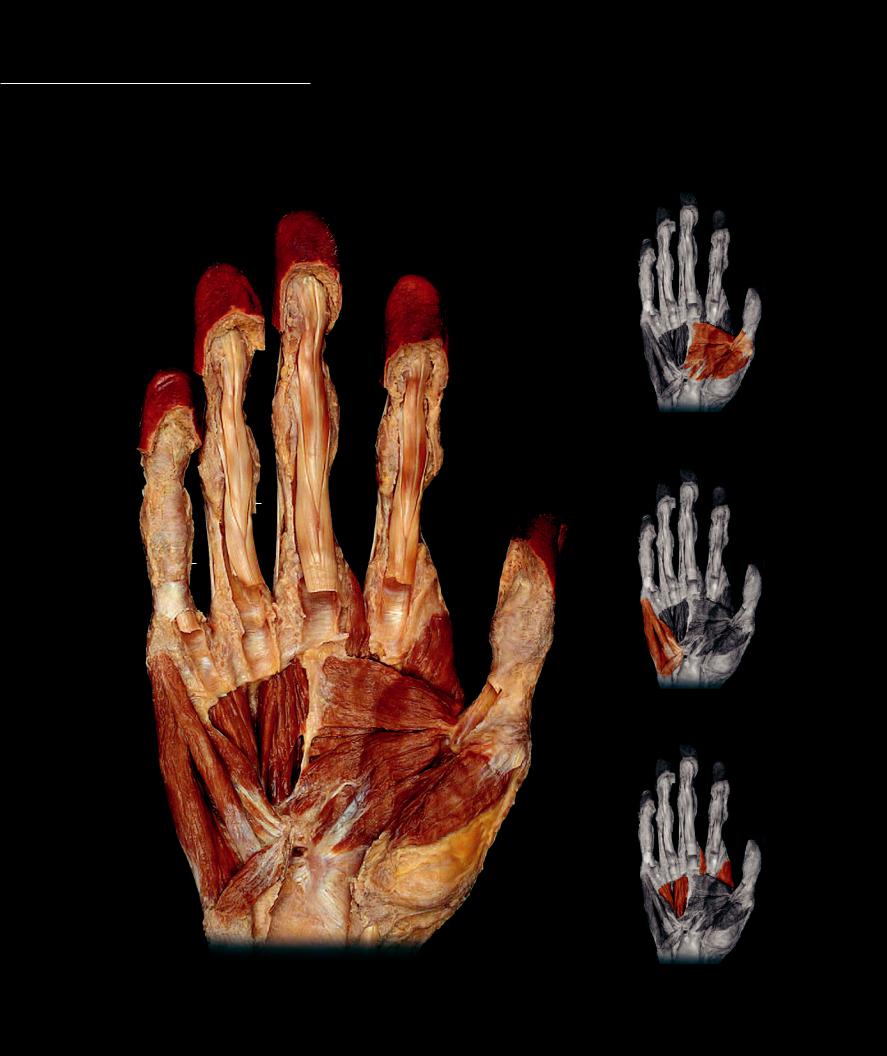
Hand Muscles |
1 |
Abductor pollicis brevis (cut) |
10 |
Palmar interossei |
|
Hand Muscles |
9 |
Lumbricals (cut) |
|
|
2 |
Flexor pollicis brevis (cut) |
11 |
Dorsal interossei |
|
3 |
Opponens pollicis |
|
|
|
4 |
Adductor pollicis |
Other Muscles and Structures |
|
|
5 |
Abductor digiti minimi |
12 |
Flexor digitorum superficialis |
|
6 |
Flexor digiti minimi brevis |
13 |
Flexor digitorum profundus |
|
7 |
Opponens digiti minimi |
14 |
Carpal tunnel |
|
8 |
Palmaris brevis |
|
|
|
|
|
|
13 |
|
|
|
|
13 |
13 |
|
|
|
|
|
|
9 |
|
|
|
|
|
|
|
|
9 |
|
12 |
|
|
|
12 |
12 |
||
|
|
|
|||
12 |
|
|
11 |
||
|
|
|
|
||
|
|
|
|
11 |
|
|
|
|
|
11 |
|
|
|
|
11 |
10 |
|
|
|
|
10 |
|
|
4
67
5
3
2
8 |
1 |
|
|
|
14 |
Muscles of the thenar eminence
Muscles of the hypothenar eminence
Deep muscles of the right hand |
Intermetacarpal muscles |
Anterior view |
|
194
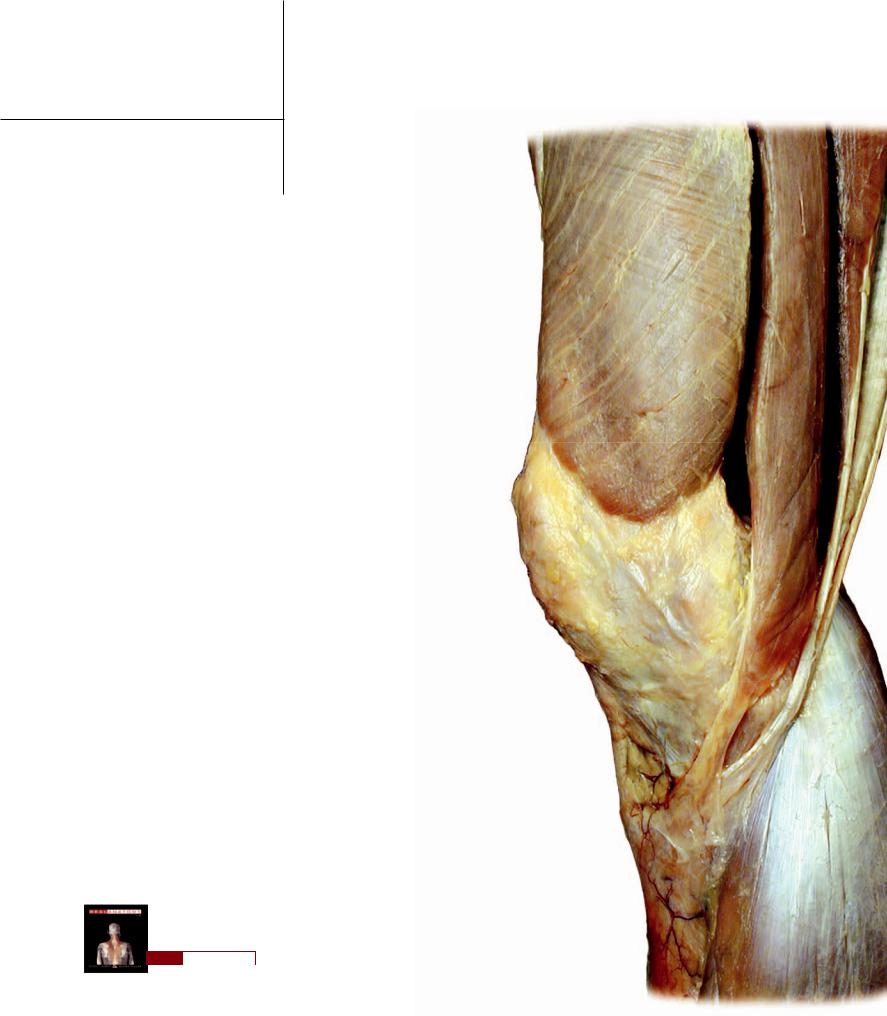
12 Lower Limb Muscles
The design of the inferior limb musculature is similar to that of the true limb muscles of the superior limb. The major difference between the two limbs is that the proximal end of the lower limb forms a direct skeletal attachment to the vertebral column via the strong sacro-iliac joint, unlike the unattached scapula of the superior limb. Because of this difference, the inferior limb does not require body wall muscles to support, stabilize, and suspend it from the axial skeleton. There are two additional features that are important to keep in mind when studying this powerful locomotor limb. First, during development of the lower limb the embryonic posterior muscles rotate and reposition themselves to the anterior aspect of the limb. For this reason the knee and ankle move directly opposite the elbow and wrist. The second notable feature is that there are three muscle compartments in the thigh and leg, as compared
to just two in the brachium and antebrachium. One of the two original compartments in each lower limb segment (thigh and leg) splits to give rise to an additional compartment. The thigh has an anterior compartment and a posterior compartment, but the posterior compartment is subdivided into posterior and medial compartments. The leg has a large posterior compartment and a smaller anterior compartment and the anterior compartment is subdivided into anterior and lateral compartments. As with the upper limb, we present the muscles of the lower limb proper in their muscle compartments. Again, this greatly simplifies the learning process because most of the muscles in a compartment share simi-
lar attachments, perform common actions, and have a common nerve supply. Unlike the compartmental muscles of the lower limb proper, the proximal muscles of the lower limb that surround the hip joint are a more diverse group of muscles. Some are true limb muscles, while others are annexed muscles from the trunk wall. We organize these hip muscles into three groups — the deep hip rotator muscles, the gluteal muscles, and the hip flexors.
Find more information about the muscles of the lower limb in
R E A L A N AT O M Y
195

The muscles of the lower limb share similarities with their upper limb counterparts, yet have important differences. As you will notice in the groups below there are no homologues in
the lower limb to the scapular muscles of the upper limb. Like the shoulder muscles, the muscles surrounding the hip joint are a varied group of muscles, with some annexed from the body wall of the abdominopelvic region. In the limb proper the muscles develop in muscular compartments as they do in the upper limb; however, the embryonic posterior aspect of the limb rotates to an anterior position. As a result, the nerves that arise from the posterior divisions of the lumbosacral plexus innervate the anterior muscle compartments, and the nerves from the anterior divisions of the plexus innervate the posterior muscle compartments. The developmental groups of muscles and their nerve supply are outlined below.
Hip Muscles Gluteal muscles
(Nerve supply - gluteal nerves, superior to maximus and inferior to the other three; arise from lateral aspect of ilium and are prime movers and stabilizers of hip joint)
Gluteus maximus Gluteus medius Gluteus minimus Tensor fasciae latae
Deep hip rotator muscles
(All are lateral rotators of the hip joint and insert on the medial aspect of greater trochancter)
Piriformis Obturator internus Obturator externus Superior gemellus Inferior gemellus Quadratus femoris
Hip flexor muscles Psoas major Iliacus
Anterior Thigh Muscles
(Nerve supply - femoral nerve; major extensor group of the knee) Sartorius
Quadriceps femoris Rectus femoris Vastus lateralis Vastus intermedius Vastus medialis
Articularis genu
Medial Thigh Muscles
(Nerve supply - obturator nerve with exception of pectineus, which is supplied by femoral nerve and condylar head of adductor magnus, which is supplied by tibial nerve)
Pectineus Adductor brevis Adductor longus
Adductor magnus Adductor minimis Gracilis
Posterior Thigh Muscles
(Nerve supply - Tibial nerve with exception of short head of biceps femoris, which is supplied by common fibular nerve)
Biceps femoris Semitendinosus Semimembranosus
Anterior Leg Muscles
(Nerve supply - deep fibular nerve) Tibialis anterior
Extensor digitorum longus Extensor hallucis longus Peroneus tertius
Lateral Leg Muscles
(Nerve supply - superficial fibular nerve) Peroneus longus
Peroneus brevis
Posterior Leg Muscles (Nerve supply - tibial nerve)
Triceps surae Gastrocnemius Soleus
Plantaris
Popliteus Tibialis posterior
Flexor digitorum longus Flexor hallucis longus
Dorsal Foot Muscles
(Nerve supply - deep fibular nerve) Extensor hallucis brevis Extensor digitorum brevis
Plantar Foot Muscles
(Nerve supply - tibial nerve via its terminal branches, medial plantar nerve supplies first lumbrical, abductor hallucis, flexor hallucis brevis, and flexor digitorum brevis; lateral plantar nerve supplies all the others)
First layer Abductor hallucis
Flexor digitorum brevis Abductor digiti minimi
Second layer Quadratus plantae Lumbricales
Third layer
Flexor halluci brevis Adductor hallucis
Flexor digiti minimi brevis Fourth layer
Plantar interossei Dorsal interossei
196
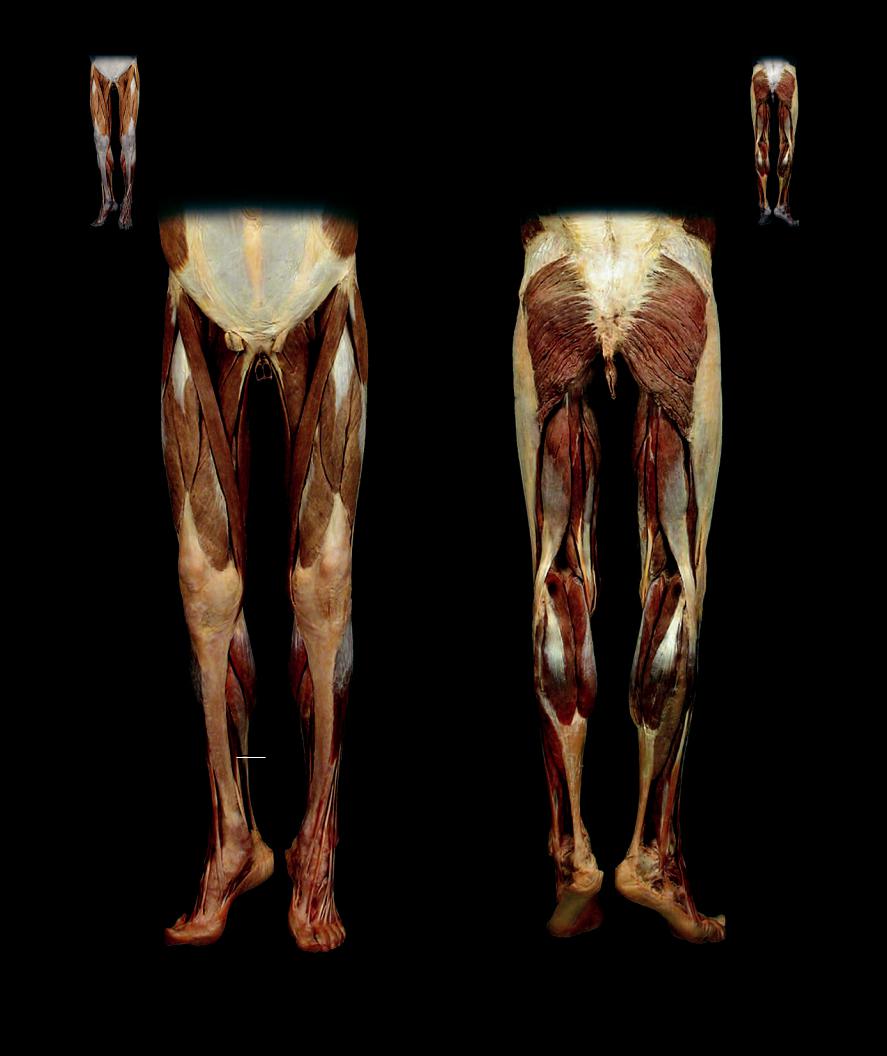
1 |
Tensor fasciae latae |
9 |
Vastus lateralis |
17 |
Soleus |
2 |
Iliacus |
10 |
Vastus medialis |
18 |
Tibialis anterior |
3 |
Psoas major |
11 |
Gluteus maximus |
19 |
Fibularis longus |
4 |
Pectineus |
12 |
Adductor magnus |
20 |
Fibularis brevis |
5 |
Adductor longus |
13 |
Biceps femoris |
21 |
Iliotibial tract |
6 |
Gracilis |
14 |
Semitendinosus |
22 |
Calcaneal tendon |
7 |
Sartorius |
15 |
Semimembranosus |
23 |
Quadriceps tendon |
8 |
Rectus femoris |
16 |
Gastrocnemius |
24 |
Flexor digitorum longus |
2
13
4
5
67
8
9
10
23
16
17 |
18 |
24
11
16
22
12
21
13
14
15
19
17
20
Muscles of the lower limb |
Muscles of the lower limb |
|
Posterior view |
||
Anterior view |
||
|
197
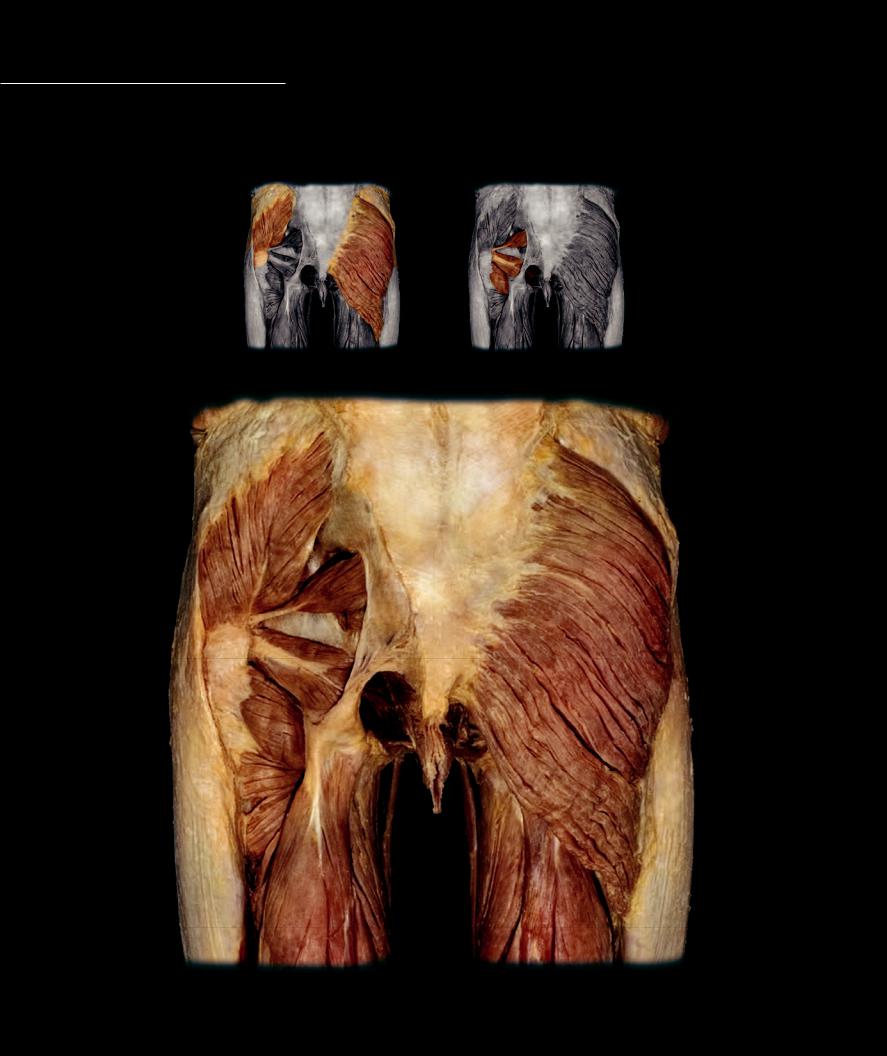
The muscles that surround the hip joint form three groups. The gluteal muscles arise from the posterior musculature of the embryonic limb bud and are prime movers of the hip joint. They create the characteristic profi le of the human buttocks. The deep hip
rotator muscles are closely associated with the body wall of the pelvic region. Five of the six muscles sit deep to the gluteal musculature on the posterior aspect of the hip joint. The hip fl exors are deep body wall muscles of the abdominal wall that have been annexed by the lower limb during development. These muscles, the psoas major and iliacus, form a pulley over the superior ramus of the pubis on their descent onto the lesser trochanter of the femur.
Gluteal muscles |
Deep hip rotator muscles |
228
4 |
5 |
|
1
6
726
8
20
7
9
17
18
16
25
13
14
15
Muscles of the gluteal region, gluteus maximus removed on left
Posterior view
198
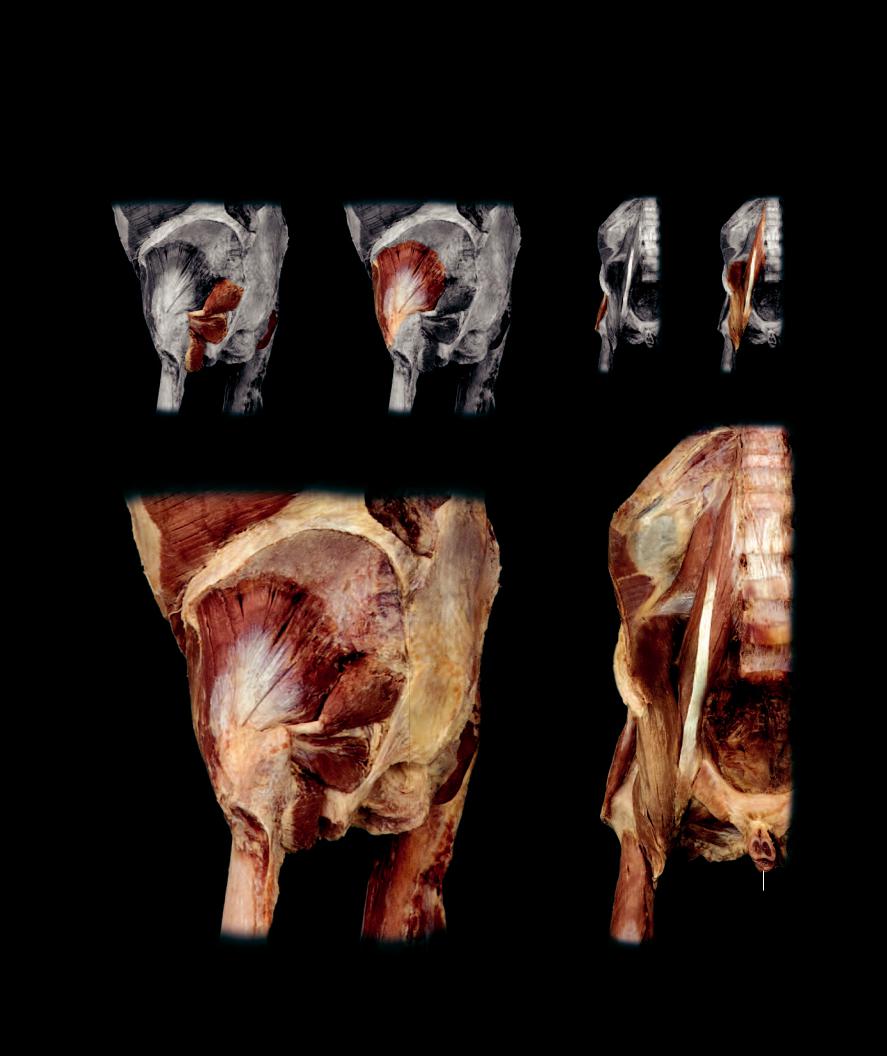
Gluteal Muscles |
7 |
Obturator internus |
Other Muscles and Structures |
21 |
Transversus abdominis |
||
1 |
Gluteus maximus |
8 |
Inferior gemellus |
13 |
Biceps femoris |
22 |
Quadratus lumborum |
2 |
Gluteus medius |
9 |
Quadratus femoris |
14 |
Semitendinosus |
23 |
Psoas minor |
3 |
Gluteus minimis |
10 |
Obturator externus |
15 |
Semimembranosus |
24 |
Pectineus (cut) |
4 |
Tensor fasciae latae |
|
|
16 |
Adductor magnus |
25 |
Iliotibal tract |
|
|
Hip Flexor Muscles |
17 |
Adductor minimus |
26 |
Sacrotuberous ligament |
|
Deep Hip Rotator Muscles |
11 |
Psoas major |
18 |
Gracilis |
27 |
Penis (cut) |
|
5 |
Piriformis |
12 |
Iliacus |
19 |
Vastus intermedius |
28 |
Ilium |
6 |
Superior gemellus |
|
|
20 |
Pelvic diaphragm |
29 |
Femur |
Deep hip rotator |
Gluteal muscles |
muscles |
|
21
28
3
5
76
26
8
9
29
Muscles of gluteal region, gluteus maximus and medius removed
Posterolateral view
Gluteal muscles |
Hip flexor muscles |
22 23
21
11
11
12
3
24
10
9
27
19
Deep dissection of iliopsoas muscles
Anterior view
199
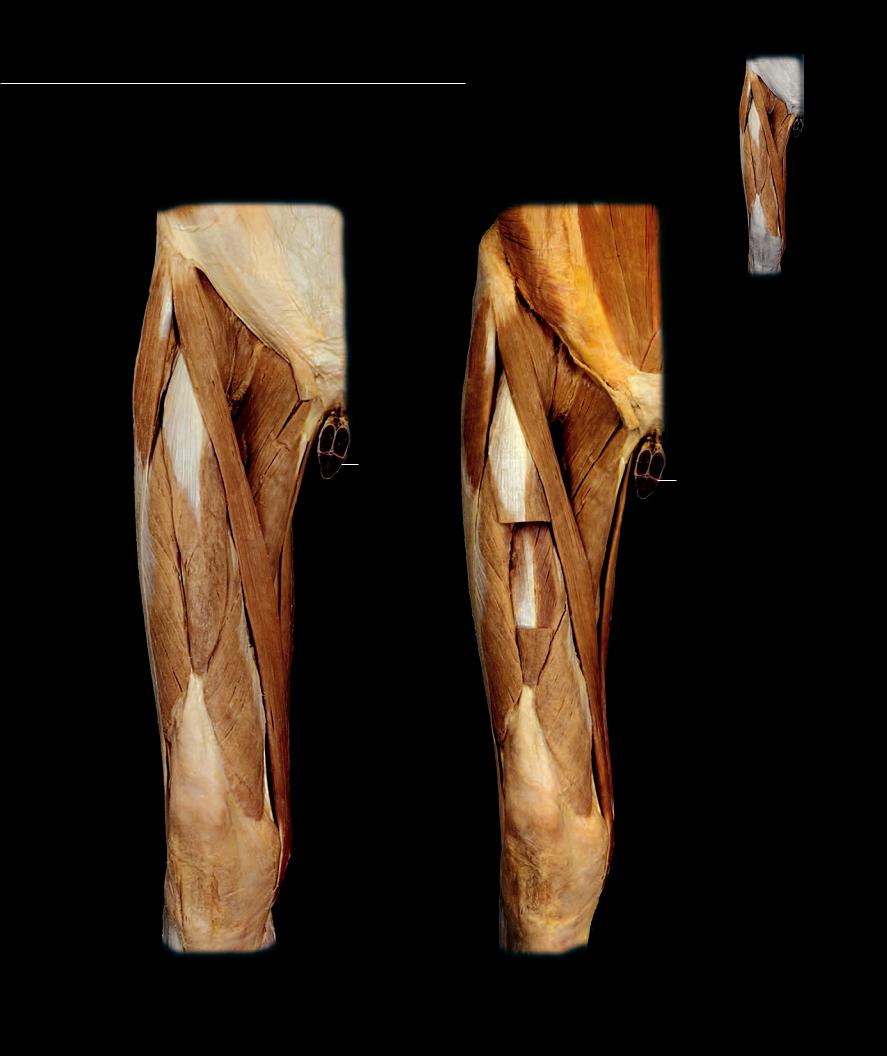
The four major muscles of the anterior compartment form the quadriceps femoris muscle group.The four muscles of this
group converge to form the strong quadriceps tendon that surrounds all but the posterior surface of the patella. As the sole extensors of the knee, the quadriceps are essential for running, jumping, and kicking. The sartorius, which is the longest muscle in the body, is a knee fl exor. The small articularis genus raises the suprapatellar bursa during extension of the knee. All of the muscles in this compartment receive their innervation via the femoral nerve from the posterior divisions of the lumbar plexus.
26
|
|
|
|
|
8 |
|
|
|
|
|
|
|
|
|
|
|
9 |
|
|
|
19 |
|
|
|
|
|
|
|
|
|
11 |
|
|
|
|
|
|
|
|
7 |
12 |
|
|
|
11 |
|
10 |
|
|
|
|
|
|
|
|
||||
|
|
|
|
|
|
|
|
|
|
|
|
20 |
7 |
|
12 |
|
|
|
|
|
13 |
|
|
|
|
|
|
||
|
|
|
|
|
|
|
|
|
|
|
|
|
|
|
|
13 |
20 |
|
|
|
|
|
|
|
|
|
|
|
|
|
5 |
|
|
|
|
|
|
|
|
|
14 |
|
|
25 |
1 |
|
14 |
|
25 |
|
|
|
|
|
|||||
|
|
|
|
|
|
|
|||
|
|
|
|
|
|
|
|||
|
|
|
|
|
|
|
|
||
|
|
|
22 |
|
|
|
|
||
|
1 |
|
|
5 |
|
|
|
||
|
|
|
|
|
|
|
|
|
|
|
15 |
|
|
|
3 |
|
15 |
|
|
|
|
|
|
|
|
|
|
||
|
|
|
|
|
2 |
|
|
|
|
2
1
4 |
4 |
Muscles of the thigh |
Muscles of the thigh, rectus femoris cut |
Anterior view, left thigh |
Anterior view. left thigh |
200
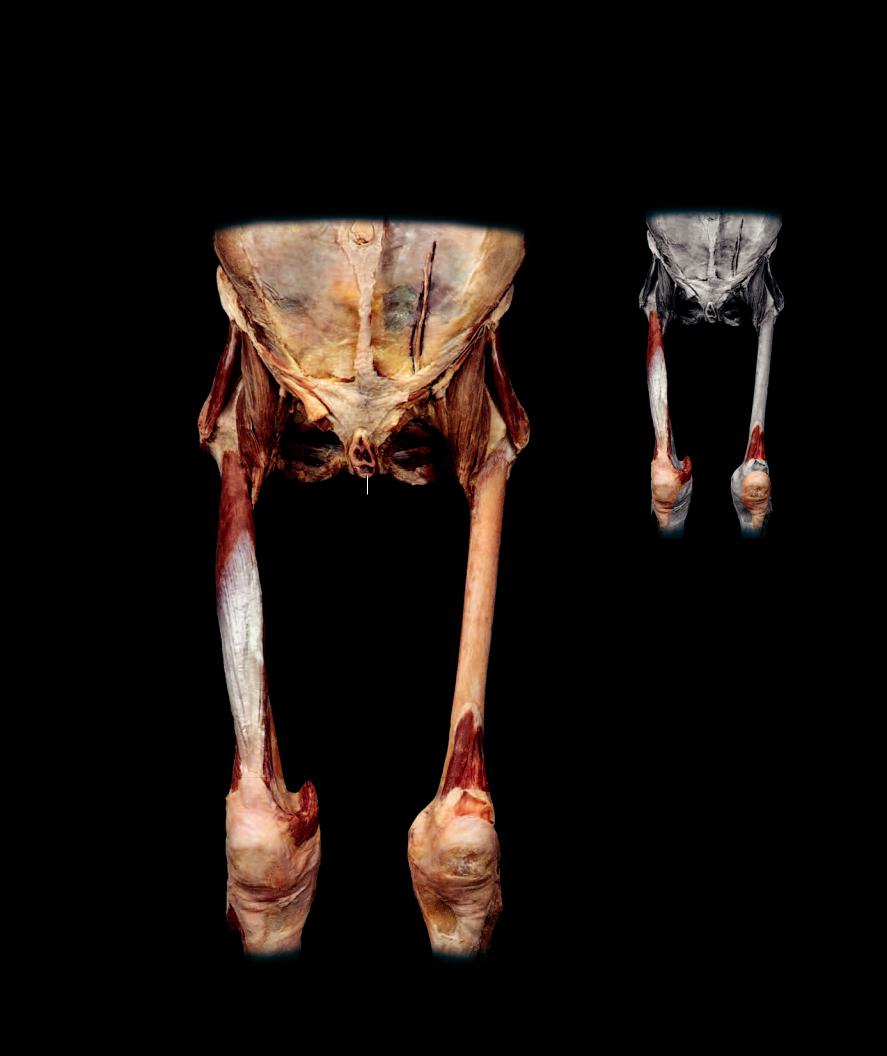
Anterior Thigh Muscles |
Other Muscles and Structures |
13 |
Pectineus |
20 |
Spermatic cord |
||
1 |
Rectus femoris |
7 |
Tensor fasciae latae |
14 |
Adductor longus |
21 |
Linea alba |
2 |
Vastus lateralis |
8 |
Transversus abdominis |
15 |
Gracilis |
22 |
Iliotibial tract |
3 |
Vastus intermedius |
9 |
Rectus abdominis |
16 |
Gluteus minimis |
23 |
Femur |
4 |
Vastus medialis |
10 |
Pyramidalis |
17 |
Obturator externus |
24 |
Inferior epigastric vessels |
5 |
Sartorious |
11 |
Iliacus |
18 |
Quadratus femoris |
25 |
Penis (cut) |
6 |
Articularis genus |
12 |
Psoas major |
19 |
Inguinal ligament |
26 |
Rectus sheath |
21 24
16
11 |
20 |
12 |
|
||
|
|
17
18
25
3
23
6
4
Deep muscles of the thigh
Anterior view
201
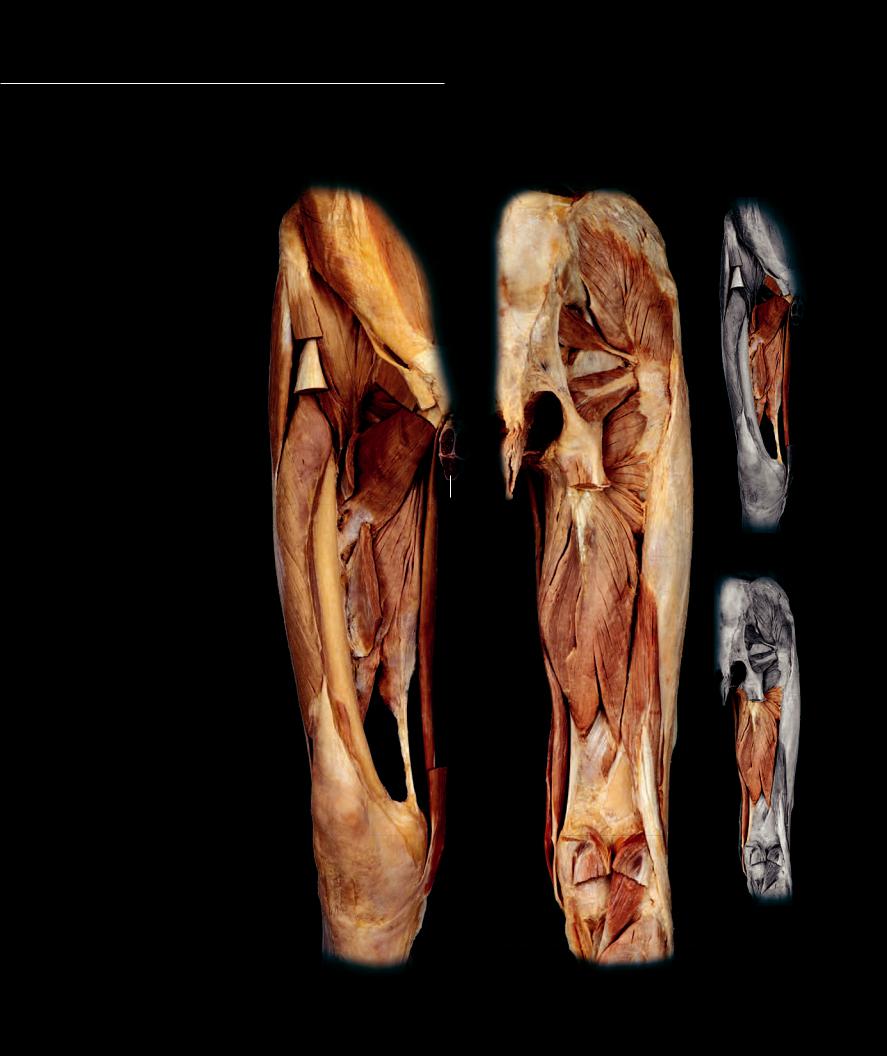
The six muscles of the medial compartment are all capable of adducting the hip joint. The pectineus and four adductor muscles all originate from a medial position on the pubis
and ischium and project laterally to insert on the posterior surface of the femur. The gracilis muscle differs from the others in the group by crossing the knee joint in addition to the hip. It courses with the sartorius muscle as a fl exor of the knee. With the exception of the pectineus and condylar part of the adductor magnus, all the muscles are innervated by the obturator nerve, which arises from the anterior divisions of the lumbar plexus.
Medial Thigh Muscles 1 Pectineus
2 Adductor longus
3 Adductor brevis
4 Adductor magnus
5 Adductor minimis
6 Gracilis
Other Muscles and Structures 7 Sartorius
8 Iliacus
9 Psoas major
10Tensor fasciae latae
11Rectus femoris
12Obturator externus
13Vastus lateralis
14Articularis genus
15Gluteus medius
16Piriformis
17Superior gemellus
18Obturator internus
19Inferior gemellus
20Quadratus femoris
21Biceps femoris (short head)
22Gastrocnemius
23Plantaris
24Soleus
25Pelvic diaphragm
26Transversus abdominis
27Rectus abdominis
28Spermatic cord
29Sacrotuberous ligament
30Femur
31Penis (cut)
202
|
26 |
|
|
|
27 |
|
7 |
|
10 |
8 |
9 |
11 |
|
1 |
|
|
|
|
|
28 |
|
|
12 |
|
|
2 |
|
1 |
3 |
|
|
3121
13
4
2
3020
6
14
7
Dissection of medial thigh muscles
Anterior view, right thigh
15
16
17 18
29
25 19
18
20
5
6
4
21
7
22
23
24
Dissection of medial thigh muscles
Posterior view, right thigh
